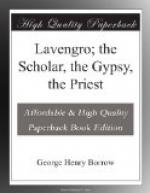‘Pannam!’ said I, ’pannam! evidently connected with, if not derived from, the Latin panis; even as the word tanner, which signifieth a sixpence, is connected with, if not derived from, the Latin tener, which is itself connected with, if not derived from, tawno or tawner, which, in the language of Mr. Petulengro, signifieth a sucking child. Let me see, what is the term for bread in the language of Mr. Petulengro? Morro, or manro, as I have sometimes heard it called; is there not some connection between these words and panis? Yes, I think there is; and I should not wonder if morro, manro, and panis were connected, perhaps derived from, the same root; but what is that root? I don’t know—I wish I did; though, perhaps, I should not be the happier. Morro—manro! I rather think morro is the oldest form; it is easier to say morro than manro. Morro! Irish, aran; Welsh, bara; English, bread. I can see a resemblance between all the words, and pannam too; and I rather think that the Petulengrian word is the elder. How odd it would be if the language of Mr. Petulengro should eventually turn out to be the mother of all the languages in the world; yet it is certain that there are some languages in which the terms for bread have no connection with the word used by Mr. Petulengro, notwithstanding that those languages, in many other points, exhibit a close affinity to the language of the horse-shoe master: for example, bread, in Hebrew, is Laham, which assuredly exhibits little similitude to the word used by the aforesaid Petulengro. In Armenian it is—’
‘Zhats!’ said the stranger, starting up. ’By the Patriarch and the Three Holy Churches, this is wonderful! How came you to know aught of Armenian?’
CHAPTER XLVII
New acquaintance—Wired cases—Bread and wine—Armenian colonies—Learning without money—What a language—The tide—Your foible—Learning of the Haiks—Old proverb—Pressing invitation.
Just as I was about to reply to the interrogation of my new-formed acquaintance, a man with a dusky countenance, probably one of the Lascars, or Mulattos, of whom the old woman had spoken, came up and whispered to him, and with this man he presently departed, not however before he had told me the place of his abode, and requested me to visit him.
After the lapse of a few days, I called at the house which he had indicated. It was situated in a dark and narrow street, in the heart of the City, at no great distance from the Bank. I entered a counting-room, in which a solitary clerk, with a foreign look, was writing. The stranger was not at home; returning the next day, however, I met him at the door as he was about to enter; he shook me warmly by the hand. ’I am glad to see you,’ said he, ‘follow me, I was just thinking of you.’ He led me through the counting-room, to an apartment up a flight of stairs; before ascending, however, he looked into the book in which the foreign-visaged clerk was writing, and, seemingly not satisfied with the manner in which he was executing his task, he gave him two or three cuffs, telling him at the same time that he deserved crucifixion.




